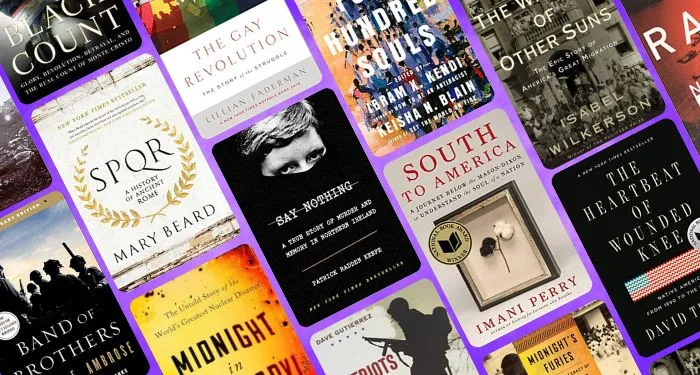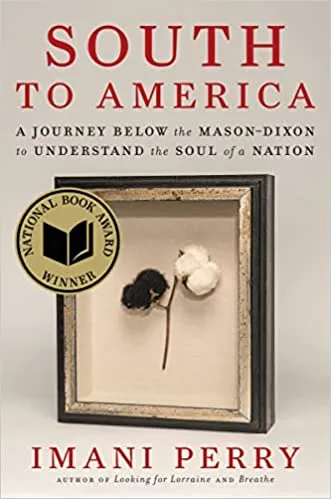
A Page From History: 24 of the Best History Books of All Time
Let’s just mention these quotes now and get them out of the way: “History is written by the victors,” and “Those who cannot remember the past are condemned to repeat it.” The first is often attributed to Winston Churchill, but it isn’t actually known if he said it first; the second was written by George Santayana in 1905’s The Life of Reason. Both overused, both very valid points. History and its tellings are often shaped by the people who had the loudest voices, the biggest guns, the most money. And until the internet came along to help spread the word about, well, everything (good and bad), it was these tellings that we relied on to learn about events. But we now live in an age where all stories can be told. That’s why we offer you this list of 24 of the best history books of all time!
History is a BROAD topic. I could start naming different events in history, and still be naming them two weeks later. So this list is just a very small selection of great history books, but they are all excellent and often the winners of awards, and they all cover different events in history. You can find lots of delightful books about microhistories, such as The Pencil: A History of Design and Circumstance by Henry Petroski or Rain: A Natural and Cultural History by Cynthia Barnett. But the books on this list are about long periods of time or events or people, and cover several things that are still relevant to occurrences happening today.
Many of the books on this list are recent-ish publications, because they contain more accurate information. You can find a recent book on pretty much any subject now that sheds new light on the truth about the past, or things that have been omitted from history books, such as the history of the 1921 Tulsa Race Massacre. So shoo, get reading, there is so much to learn!

Band of Brothers: E Company, 506th Regiment, 101st Airborne from Normandy to Hitler’s Eagle’s Nest by Stephen E. Ambrose
Ambrose was considered one of the finest historians of his time, and penned many history books that earned him accolades. But this is widely considered his best. It’s the story of Easy Company, a group of soldiers in World War II, from their training in Georgia to the fighting on the frontlines in Europe, starting with D-Day. (This is also the basis for the award-winning miniseries.)

SPQR: A History of Ancient Rome by Mary Beard
This book about the creation of Ancient Rome quickly became a classic. Beard, an English scholar of Ancient Rome, discusses how, two thousand years ago, a small village in Italy built itself up to become a superpower that still influences many aspects of modern society.

The Nutshell Studies of Unexplained Death by Corinne May Botz
Frances Glessner Lee was an American whose interest in science as a child led her to help create the science of forensics as we know it today. She built 20 dioramas of crime scenes, paying excruciating attention to detail, and these dioramas were used to train crime scene investigators. You can see them all here, beautifully captured in this book. Given our nation’s recent obsession with true crime, this seemed like a perfect book to include.

The Rape Of Nanking: The Forgotten Holocaust Of World War II by Iris Chang
This is an account of how, in December 1937, the Japanese army stormed the city of Nanking, China, and raped, tortured, and murdered over 300,000 citizens. Chang’s own grandparents escaped the massacre, and she pieces together this historic atrocity using stories from Chinese citizens, Westerners, and Japanese soldiers.

This Republic of Suffering: Death and the American Civil War by Drew Gilpin Faust
With the invention of transportable cameras, the American people were faced with images of the casualties of war for the first time during the Civil War. Drew Gilpin Faust, former president of Harvard University, explains the effect of 600,000 dead soldiers had on the country, from the invention of modern funeral embalming, to American’s first experiences seeing war firsthand.

Patriots from the Barrio: The Story of Company E, 141st Infantry: The Only All Mexican American Army Unit in World War II by Dave Gutierrez
Gutierrez grew up hearing stories of his father’s cousin Ramon, who he was told earned a Silver Star, three Purple Hearts, and escaped from the Germans twice. As an adult, Gutierrez decided to investigate for himself. Through his extensive research, he details the story of Ramon’s Company E, 141st Infantry, which was comprised entirely of Mexican Americans. It was the only such unit in the entire U.S. Army, and has largely gone unrecognized by history.

The Gay Revolution: The Story of the Struggle by Lillian Faderman
An extensive look at the history of the LGBTQ+ movement, from centuries of injustices to recent hard-won victories. Faderman offers personal glimpses into history with interviews from many people who were on the front lines of the battle for equality and have worked to help the LGBTQ+ community gain ground.

Midnight’s Furies: The Deadly Legacy of India’s Partition by Nisid Hajari
In 1947, British India gained independence from India and became two states: India and Pakistan. But before this, in 1946, fighting broke out in Calcutta and the violence perpetrated in that summer changed what was supposed to be a peaceful event for all. Hajari explains how it all turned and how the results still influence that region today.

Dispatches by Michael Herr
Widely considered to be the greatest book about the Vietnam War, or any war, American correspondent Herr used his notes from front-line reporting and interviews with the soldiers and turned them into this masterpiece. It was one of the first works to truthfully highlight the experiences of the American soldier in the Vietnam War.

Midnight in Chernobyl: The Untold Story of the World’s Greatest Nuclear Disaster by Adam Higginbotham
Using recently uncovered and released documents and interviews, Higginbotham recreates the events of one of the world’s greatest nuclear disasters, the explosion of Reactor Number Four of the Chernobyl Atomic Energy Station. He explains how negligence and secrecy allowed the 1986 catastrophe to become as wide-scale and dangerous as it did, and the coverups and corruption that occurred after the disaster.

Say Nothing: A True Story of Murder and Memory in Northern Ireland by Patrick Radden Keefe
Keefe discusses the Troubles, a 30-year conflict in Northern Ireland, by way of the true story of Jean McConville. She was a 38-year-old widow and mother of ten who was kidnapped from her Belfast home in 1972 by the IRA. Say Nothing, a riveting true crime read and an excellent history book, gives a detailed examination of the conflict in Northern Ireland and its aftermath.

Four Hundred Souls: A Community History of African America, 1619-2019 by Ibram X. Kendi and Keisha N. Blain
Kendi and Blain have edited this collection of pieces by 90 writers that each cover a different five-year period from the last 400 years of Black history in America. From the arrival of enslaved Africans in 1619 to the present day, this variety of works creates a detailed work of human suffering, endurance, and hope.

The Skies Belong to Us: Love and Terror in the Golden Age of Hijacking by Brendan I. Koerner
This is a wildly fascinating look at the history of plane hijackings. They started out as mostly protests over the war and politics, and then became about money (like the story of the elusive D.B. Cooper), and then became about terror. In between the history is the tale of the couple responsible for the longest-distance hijacking in American history.

Battle Cry of Freedom: The Civil War Era by James M. McPherson
Historian McPherson took on the daunting task of explaining the politics and unrest that started the American Civil War, up through Lee’s surrender at Appomattox. This tome received the Pulitzer Prize for nonfiction, and is widely considered one of the greatest overviews on the subject.

South to America: A Journey Below the Mason-Dixon to Understand the Soul of a Nation by Imani Perry
And this is the most recent winner of the National Book Award for nonfiction! Combining memoir, history, and investigative reporting, Perry recounts her experiences driving through the American South, where she grew up as a child, and seeing it with fresh eyes. It’s a fascinating exploration of historical erasure, racism, and resilience.

The Black Count: Glory, Revolution, Betrayal, and the Real Count of Monte Cristo by Tom Reiss
This Pulitzer-winning biography reads like a swashbuckling adventure! It’s the story of General Alex Dumas, a French soldier in Napoleon’s army and father of the novelist Alexandre Dumas, whose exploits influenced his son’s classic works The Count of Monte Cristo and The Three Musketeers.

The Other Slavery: The Uncovered Story of Indian Enslavement in America by Andrés Reséndez
Reséndez explains how new information sheds light on the often-ignored mass enslavement of tens of thousands of Indians, which was responsible for the decimation of Indian populations in North America. Despite being “illegal” it was still carried out across the continent.

Hidden Figures: The American Dream and the Untold Story of the Black Women Mathematicians Who Helped Win the Space Race by Margot Lee Shetterly
The basis for the hit movie of the same name, this is the true story of the brilliant Black women who helped America win the space race despite not being treated as equals, or even allowed to dine with the other workers at NASA.

Bloods: An Oral History of the Vietnam War by Black Veterans by Wallace Terry
This was the first time the American people heard first-hand accounts from Black soldiers who fought in Vietnam. In interviews with 20 veterans, the men describe the racism and prejudice they experienced from white soldiers and high-ranking officials, while explaining how disproportionate numbers of Black men were sent overseas to fight.

Blood in the Water: The Attica Prison Uprising of 1971 and Its Legacy by Heather Ann Thompson
For the first time, this award-winning book uses newly uncovered and declassified information about the famous 1971 uprising that resulted in the deaths of dozens of people and the injuries of 100 more. Thompson explains the events leading up to those four days, and how four decades later, family members of the deceased still don’t know the truth of what happened to their loved ones.

The Heartbeat of Wounded Knee: Native America from 1890 to the Present by David Treuer
Treuer, who is Ojibwe from the Leech Lake Reservation in northern Minnesota, explains how most information about Native Americans found in history books stops after the massacre at Wounded Knee. This is a detailed look at Native Americans and their achievements and history in America over the last century since Wounded Knee.

The Guns of August: The Outbreak of World War I by Barbara W. Tuchman
Compared to World War II, there are far fewer books on the First World War. This is widely considered the greatest on the subject, and one of the top history books of all time in general. This is historian Barbara W. Tuchman’s award-winning comprehensive look at the first 30 days of the summer of 1914 that began the conflict.

The Warmth of Other Suns: The Epic Story of America’s Great Migration by Isabel Wilkerson
And this is Pultizer Prize–winning author Wilkerson’s account of the Great Migration, when over the course of 60 years, over six million Black people fled the south for northern and western towns and cities, which changed the face of the country. Many personal accounts of their journeys are captured in this fascinating book.

Last Boat Out of Shanghai: The Epic Story of the Chinese Who Fled Mao’s Revolution by Helen Zia
In 1949, fearful of what Mao’s new Communist Revolution would do to them and their country, mass numbers of people fled Shanghai. Zia interviewed four of those people and recounts the story of that period in time, their escape from the city, and where they ended up after they fled.
And if you want to get even more knowledge about history into your brain pan, check out this introduction to U.S. disability history books, 20 of the Best World History Books, Learn Your Historia with These 20 Mexican History Books, 6 of the Best Islamic History Books, and 15 of the Best Books on Roman History. I also highly recommend the You’re Wrong About podcast, for some general and esoteric learning. (That poor McDonald’s coffee lady!)




